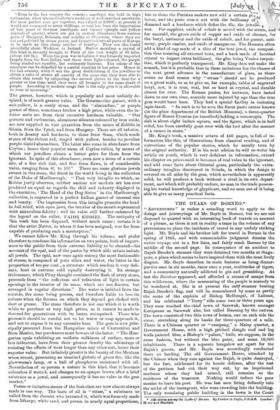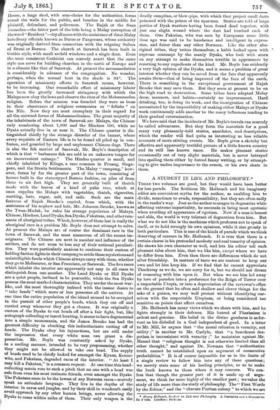THE DYAKS OF BORNEO.* " ADVENTURES " is rather a
sounding word to apply to the doings and journeyings of Mr. Boyle in Borneo, but we are not disposed to quarrel with an interesting book of travels on account of a phrase, as there is not in reality a trace in the volume of any pretensions to place the incidents of travel in any unduly striking light. Mr. Boyle and his brother left for travel in Borneo in the spring of 1863, and with commendable judgment dismiss the entire voyage out in a few lines, and fairly reach Borneo by the middle of the second page. In consequence of an accident to Rajah Brooke's steamer they were detained two months at Singa- pore, a place which seems to have inspired them with the most lively disgust. Mr. Boyle describes its main features as being dinner- parties once in six months, races once a year, multitudes of tigers, and a community naturally addicted to gin and grumbling. At last the Rainbow appeared, and afforded a means of escape from this wilderness, where the murmuring of the people is scarcely to be wondered at. She is at present the only steamer bearing Rajah Brooke's flag, and will be remembered by some as partly the scene of the exploits of Bishop McDougal, of Iabnan, and his celebrated " Terry " rifle some two or three years ago. They soon reached the chief town of Sarawak, known amongst Europeans as Sarawak also, but called Ruening by the natives. The town consists of two thin rows of houses, one on each side the river, stretching along its banks for three-quarters of a mile. There is a Chinese quarter or " campong," a Malay quarter, a Government House, with a high pitched shingle roof and log walls painted blue, a Bishop's "palace," built, we suppose, in the same fashion, but without the blue paint, and some 18,000 inhabitants. There is a separate bungalow set apart for the Rajah's guests, and Mr. Boyle was accordingly conducted there on landing. The old Government House, attacked by the Chinese when they rose against the Rajah, is quite destroyed, but the fort, celebrated for its heroic defence, after the rest of the garrison had cut their way out, by an imprisoned madman whom they had armed, still remains as the residence of the treasurer. Nothing would induce the poor maniac to leave his post. He was last seen firing defiantly into the midst of the insurgents, who were crowding into the building. The only remaining public building in the town is the Court
defoolteireaspeoleg the Deis of Borneo. By Frederick Boyle, F.B.G.13. London : Hurst and Blackett
ltoosedan—the latter part of the title being a Malay corruption of theword " Resident "—try all cases with the assistance of three Malay hereditary officials known as Datus or Pangerans, whose authority -was originally derived from connection with the reigning Sultan of Bruni or Borneo. The church at Sarawak has been built in Gothic style, with small archdd windows and a single door. Even the most consistent Gothicist can scarcely assert that the same style can serve for building churches in the north of Europa and in a climate like that of Sarawak. At present the accommodation is considerably in advance of the congregation. No wonder, perhaps, when the normal heat in the shade is 940. The operation of missionary efforts in Sarawak seems, however, to be increasing. One remarkable effect of missionary labour has been the greatly increased stringency with which the Malaya now obey the laws and observe the rites of the Mohammedan religion. Before the mission was founded they were as loose in their observance of religious ceremonies as " fellahs " on the Nile. Now they are most exemplary in their regard for all the outward forms of Mohammedanism. The great majority of the inhabitants of the town of Sarawak are Malays, the Chinese only numbering about 1,000 and the ilindoos 500, while no Dyaks actually live in or near it. The Chinese quarter is dis- tinguished chiefly by the strange disorder of the bazaar, where every requisite of Eastern life is to be found all piled up in con- fusion, and guarded by large and unpleasant Chinese dogs. There is also the fish market of Sarawak, Mr. Boyle's description of which is that "barbarous fish are sold in an unknown tongue for an inconvenient coinage." The Hindoo quarter is small, and chiefly inhabited by Klings, a race common in Penang, Singa- pore, and the Straits Settlements. The Malay " campong," how- ever, forms by far the greater part of the town, consisting of houses built in the stereotyped Borneo fashion, on piles of from three to six feet high. They are generally built of thatch made with the leaves of a kind of palm tree, which at once supplies the Malays with -vegetables, thatch, cigarettes, matting, hats, sugar, salt, and sails. Such are the main features of Rajah Brooke's capital, from which, with the assistance of his nephew and heir, Mr. Johnson-Brooke, known as the Twan-Mudak, he rules his strange population of Malays, Chinese, Hindoos, Land Dyaks, Sea Dyaks, Pakatans, and other rem- mints of aboriginal tribes. Which, however, of these last is reallythe aboriginal race is a problem Mr. Boyle does not attempt to solve. At present the Malaya ar3 of course the dominant race in the town of Sarawak, and the most numerous of all the recent im- migrants. The Chinese are next in number and influence of the settlers, and do not seem to lose any of their national peculiari- ties. They were particularly anxious to continue their custom of holding faction fights in their campong to settle those mysterious and unintelligible feuds which Chinese always carry with them, whether
• they go to Melbourne, or San Francisco, or Sarawak. The five races which inhabit the interior are apparently not easy in all cases to distinguish from one another. The Land Dyaks or Hill Dyaks are a quiet people, inclined to be peaceable, while the Sea Dyaks possess the most marked characteristics. They are far the most war- like, and the most thoroughly imbued with the insane desire to "take heads" which more or less possesses all the natives. At one time the entire population of the island seemed to be occupied in the pursuit of other people's heads, which they cut off and carried away whenever they got a chance. It was originally a custom of the Dyaks to cut heads off after a fair fight, but, like autograph collecting or insect hunting, it seems to have degenerated into a simple monomania, and Sir James Brooke has had the greatest difficulty in checking this indiscriminate cutting off of heads. The Dyaks obey his injunctions, but are still under the impression that every white man can grant a dis- pensation. Mr. Boyle was constantly asked by Dyaks, in a smiling manner, intended to be very prepossessing, whether they might not be allowed to take one head. The supply of heads used to be chiefly looked for amongst the Kyans, Kenno- wits, and Pakatans, degraded races of the interior. "At least I may kill a Pakatan," is a common request. At one time this head- collecting mania rose to such a pitch that no one with a head was safe from even his most intimate friends, even amongst the Dyaka. The Pakatans seem to be the lowest of any Bornean races—scarcely speak an articulate language. They live in the depths of the interior, in caves and jungles, and by their skill in woodcraft easily avoid approach by any other human beings, never allowing the Dyaks to come within miles of them. Their only weapon is the House, a large shed, with arm-chairs for the authorities, forms round the walls for the public, and benches in the middle for plaintiff, defendant, and policemen. The Rajah or the Suan deadly sumpitan, or blow-pipe, with which they project small darts poisoned with the poison of the upas tree. Stories are told of large parties of Dyak warriors having been found dead together, with just one slight wound where the dart had touched each of them. One Pakatan, who was seen by Europeans some little time ago was said to be handsome and intelligent in expres- sion, and fairer than any other Bornean. Like the other abo- riginal tribes, they tattoo themselves, a habit looked upon with supreme contempt by the manly Dyaks, who look with scorn on any attempt to make themselves terrible in appearance by resorting to any expedients of the kind. Mr. Boyle has evidently a very high opinion of the Dyaks, and it seems a problem of great interest whether they can be saved from the fate that apparently awaits them—that of being improved off the face of the earth. There is something in the exceptional government of Rajah Brooke that may save them. But they seem at present to be on the high road to destruction. Some tribes have adapted Malay drew, manners, and habits—certainly no improvement. Hard drinking, too, is doing its work, and the immigration of Chinese necessitated by the impossibility of making either Malays or Dyaks work continuously adds another to the many influences tending to their gradual extermination.
We have said that the incidents of Mr. Boyle's travels can scarcely be called adventures. But they form the materials for a good many very pleasantly-told stories, anecdotes, and descriptions, which the reader will find quite as interesting as less reliable accounts of more stirring events. Mr. Boyle gives a sketchy but effective and apparently truthful picture of a little-known country and its still less known races. He makes pleasant stories occasionally out of very slight materials, but is never betrayed into spoiling them either by forced funny writing, or by attempt- ing to give undue importance to the events, or his own share in them.































 Previous page
Previous page